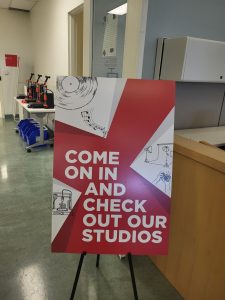
Pens, Photo by Jess Bailey Designs: https://www.pexels.com/photo/three-ball-point-pens-983826/
Students at our academic library often approached our reference and circulation desks to ask for pens and other stationary supplies. Some of us would happily give a pen if we had one to spare and try to help if we didn’t. Other staff would get angry at the students and be snappish at being interrupted by such a small request. That small interaction was often the first encounter students had with our library staff and was a chance to start forming a hyperlink between our library and the user. As our Hyperlinked Communities lecture mentions, hyperlinks can happen between people in conversations. I feel like every small interaction counts as a possibility for connections. If I were made to feel bad for a small question like asking for a pen, I might develop bad feelings about the library, and the chance for a hyperlink would be gone.
Stephens (2014) discusses in The Heart of Librarianship how we must find ways to help all users through little things and big ideas. Libraries are more than our collections; they can be welcoming spaces providing necessary community-building and wellness opportunities. But we can’t assume our libraries are welcoming. We need to reach out to our users to make sure they know they are welcome, and we need to work to create opportunities, big and small, for connection. While we still need big, fearless ideas, I also find that the small choices we make every day and the small ideas we implement are essential.
For example, working in an academic makerspace, I know that makerspaces can be intimidating or unwelcoming to many. We have tried eliminating barriers by not charging extra fees and opening our space to everyone in our college community, not limited to academic projects. However, we would still notice users hesitating to come in or apologizing for asking questions.
One fascinating study used VR to understand the experiences of underrepresented communities seeing a makerspace for the first time. The observations found that simply having access to technology or open spaces wasn’t enough for a welcoming space. However, they found that even relatively small changes like signage and seeing familiar items could help makerspaces feel more accessible.
We’ve tried to implement some of these ideas in our own space. For example, recently, one of our student staff designed this new sign to let users know they’re allowed in.

Photo Caption: Come on in and check out our studios sign in front of makerspace
We have 3D prints of familiar characters and a whiteboard where we encourage users to add artwork. We also focus on hiring and training for user-focused practices, looking for student staff with technical skills and a genuine interest in helping others and sharing their knowledge. There’s still work to be done, but we do notice more people dropping by to learn more about our space and less hesitation.
My team is about to start an initiative to review our entire digital literacy program. I’m excited to see what big and small ideas we’ll gather from our staff and users to continue working towards a community-driven, welcoming makerspace.
Oh wow Alana,
That is really fascinating that a small thing such as sign can create such change. I wonder if the reluctance to use the Makerspace could be related to not wanting to do something wrong or assuming that the space was for staff only.
I think you’re right that there is some fear around making mistakes mixed with not knowing if the space or resources are ok to use. That sense of needing permission came up in that study on makerspaces, and I have seen it in other library spaces and services.
We often get students asking us things like if they’re allowed to borrow items, if they’re allowed to use the space to study, if we charge any fees to use our services. Sometimes it’s because they’re international students and their countries may not have free libraries, or they may work differently. Sometimes even domestic students haven’t had much exposure to libraries, even in Toronto where we have 100 branches in our public library system. So we have to work to share the message that all are welcome.
@alanao I so appreciate this on the ground reflection of the module with your own work and environment. I agree: a negative interaction around something so small as borrowing a pen can leave a lasting effect on a student. Thanks for sharing the super cool picture of the sign.
Thank you!